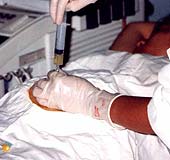Detection of fetal malformations through prenatal diagnosis
Currently, with the method of prenatal diagnosis using screening tests, physicians can detect fetal malformations from within the womb and have timely treatment.

Amniocentesis to perform a diagnosis of malformations in the fetus through the result of chromosomal chromosome (Photo: employee)
Every year, Tu Du City Hospital (BV) has about 300 babies born with birth defects sent to the Neonatal Department. In Hung Vuong Hospital in Ho Chi Minh City, in 2004 there were 82 cases of birth defects, accounting for 0.31% of births in this hospital year, in 2005 this number increased to 148 cases, accounting for 0.53% .
Unborn baby 1 chromosome 21
In early July 2006, Mrs. NTMN, 31 years old, residing in Tan Binh District - Ho Chi Minh City, pregnant for 20 weeks, went to Tu Du Hospital in Ho Chi Minh City to do a diagnostic test for Down syndrome in the fetus. From the beginning of her pregnancy, Mrs. N. regularly went to check up at Tu Du Hospital. Initial tests show that the fetus is normal. However, through the 20th week, some tests show something unusual in the fetus. At her request, the Department of Genetics doctors had amniotic fluid and made the fetus chromosome. As a result, unborn babies 1 chromosome 21, signs of Down syndrome. After several attempts, the doctors decided to advise Ms. N. to terminate the pregnancy.
Elderly mother, children are prone to deformities
Vietnam is the country with the highest rate of children with birth defects in the world. That is the professor's remark - Dr. Tran Dong A, Deputy Director of Ho Chi Minh City Children's Hospital 2. The cause has not been clearly defined, however, there are related factors such as genetics, chromosomal disorders, pregnant women exposed to radiation or chemicals during pregnancy, improper use of drugs. The way . In particular, the older women get older, the more likely they are to be malformed. 20-year-old pregnant woman, the rate of childbirth with Down syndrome is 0.06%; By the age of 25, this ratio increased to 0.08% and exceeded 0.1% at the age of 30. Through statistics at Tu Du Hospital, hydrocephalus was the highest rate, followed by congenital heart disease. , chromosomal disorders, Down syndrome, cranial pregnancy, clubfoot, cleft lip - cleft palate, umbilical hernia .
Depending on the degree of fetal malformations that will be detected sooner or later. Large defects, detected as easily as cranial or multiple malformations, can be detected in the 9th week of pregnancy through ultrasound. Doctor - Dr. Vu Thi Nhung, Director of Hung Vuong Hospital, said that for these cases, physicians often advised pregnant women to end the pregnancy because the baby could not live after birth.
For milder deformities, more difficult to detect, wait until the test in the week of pregnancy from the 5th month onwards. With small, treatable defects such as cardiovascular, abdominal wall opening, spinal fracture, cleft palate - cleft palate . obstetricians will monitor and consult with other specialties or Pediatric hospital for surgery for babies when they are born. Besides, pregnant women are also prepared to limit the traumas at birth.
Periodic pregnancy screening should be performed
According to Dr. Huynh Thi Thu Thuy, Deputy Director of Tu Du Hospital, from the 14th week of pregnancy onwards, pregnant women should perform pregnancy screening tests. In the first 13 weeks, pregnant women are given diagnostic tests to know if the fetus has an embryo and how it works with ultrasound. From the 13th week of pregnancy, doctors will apply blood tests to diagnose certain defects in the fetus. If findings are suspected, the doctor will continue to perform chromosomal analysis through amniocentesis and implantation of amniotic fluid.
Dr. Phung Nhu Toan, Tu Du BV Genetics, recommends, terminating pregnancy for malformed pregnancies as well as abortion, if not careful, can cause complications for pregnant women and lead to infertility due to blocked the fallopian tube. The fetus suffers from major malformations, if it is not detected to terminate early pregnancy, it is easy to cause obstetric complications at birth, women can have uterine rupture and lead to death.
- Unusual fetal findings from 7 weeks of age
- New measures to diagnose Down syndrome in the fetus
- Sex detection of 5-week-old fetus
- Mother's blood revealed the secret of the fetus
- WHO: First detected African American Zika virus strain in Africa
- New method to detect fetal Down syndrome through maternal blood
- Screening program for early detection of breast cancer
- Detection of sperm structure may contribute to infertility
- Decoding the drug makes more than 10,000 babies with malformations
- The world's best ultrasound technology helps detect abnormalities in the fetus
- Smart paper guessing disease
- Newborn baby girls have two heads
 Green tea cleans teeth better than mouthwash?
Green tea cleans teeth better than mouthwash? Death kiss: This is why you should not let anyone kiss your baby's lips
Death kiss: This is why you should not let anyone kiss your baby's lips What is salmonellosis?
What is salmonellosis? Caution should be exercised when using aloe vera through eating and drinking
Caution should be exercised when using aloe vera through eating and drinking